#pattern is flax!
Explore tagged Tumblr posts
Text

one down one to go!! yippee!! started the other sleeve last night but it seems the ysrn changes s bit in the last stretch, so the color blocks wont be the same length :((
22 notes
·
View notes
Text

real
#made this#it's a trout original#pattern is flax from tin can knits#and yarn is caron cloud cakes#in the colorway salt water taffy
4 notes
·
View notes
Text

sweater in progress
#pattern is#The Flax Sweater (Worsted) by TinCanKnits#it's free!#and their app is actually super cool for this project#knitting#knit sweater#ks talks
5 notes
·
View notes
Text
Weaving Wonders: Unraveling the Magic of Textile Industries
Introduction:
Welcome to a fascinating exploration of the world behind the fabrics we wear and cherish. Textile industries are the hidden architects of our daily attire, turning threads into art and creativity. In this blog post, we'll embark on a journey through the intricate web of textile production, discovering the magic that happens behind the scenes.
The Art of Fiber:
Textile industries are masterful creators, transforming raw fibers into a symphony of colors and textures. From the soft embrace of cotton to the luxurious touch of silk, each fiber tells a unique story. Grade 4 students, imagine the excitement of seeing fluffy cotton transformed into cozy pajamas or witnessing silk threads dance into elegant dresses!
From Farm to Fabric:
Our adventure begins on the farms where cotton, wool, and other fibers are cultivated. Learn about the importance of sustainable farming practices that ensure the health of the environment and the well-being of farmers. Follow the journey of these raw materials as they travel from the fields to the textile mills, where the magic truly begins.
The Dance of the Looms:
Enter the enchanting world of weaving and knitting machines, where threads intertwine to create beautiful patterns. Discover the precision and skill required to operate these marvels of engineering. Grade 4 students, can you imagine the rhythmic dance of the looms, bringing to life the fabrics that eventually become your favorite clothes?
Colors, Patterns, and Designs:
Textile industries are not just about creating fabrics; they're also about crafting a visual feast. Explore the exciting realm of dyeing and printing, where colors and patterns come to life. Learn about the creative minds behind the designs, making every piece of fabric a unique work of art.
Innovation and Technology:
Step into the future as we explore how technology has revolutionized the textile industry. From 3D printing fabrics to sustainable innovations, witness the incredible ways in which science and creativity combine to shape the fabrics of tomorrow.
Conclusion:
Our journey through the textile industries has been nothing short of magical. Grade 4 students, the next time you put on your favorite outfit, remember the incredible story woven into the fabric. Textile industries are not just about making clothes; they're about creating a canvas for self-expression, comfort, and style. Let's continue to appreciate the artistry and craftsmanship behind the clothes we wear, celebrating the wonders of textile industries!
1 note
·
View note
Text
The depth of the global textile supply chain that you get into as you get into increasingly obscure fiber arts is so wild.
You can start with knitting, or crochet, and there are *so* many choices for yarn and materials. Indie dyers with unique colorways, weird fibers from heritage breeds, and patterns for hundreds of lifetimes worth of hobby. You can even dive into spinning! Buy weird fiber from hobbyists and conservationists around the world, and spin things that you can't easily get otherwise.. Just those skills are enough to take a lifetime to hone.
But if you go far enough down the rabbit-hole, you're suddenly googling for how to compare thread weights between crochet thread numbers and weaving numbers, and is flax graded differently than cotton? Oh, I can get 20/2 and 60/2 silk all day long, but suddenly if I need 30/2 silk there are just a handful of results and wow I'll never be able to buy this again, is this a random mill in Turkey just selling cone ends??? And before you know it you have a note file with 10,000 Etsy links and Google translated half functioning corporate websites and you're trying to figure out if it's worth it to just see if you can import from this tiny store in Germany that seems to have a reliable source of *close enough* fiber for what you're going for, and why are you even so into *tablet weaving* of all things, why can't we just be knitting endless socks or something like that???
Love it, wouldn't trade it for the world.
1K notes
·
View notes
Text
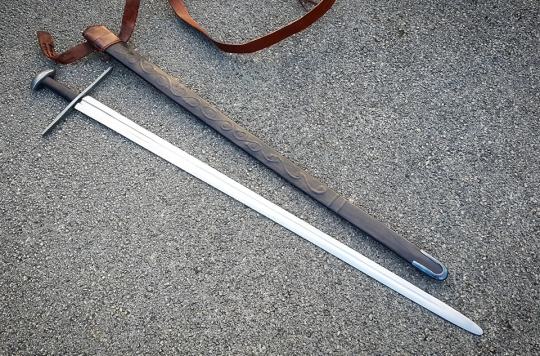
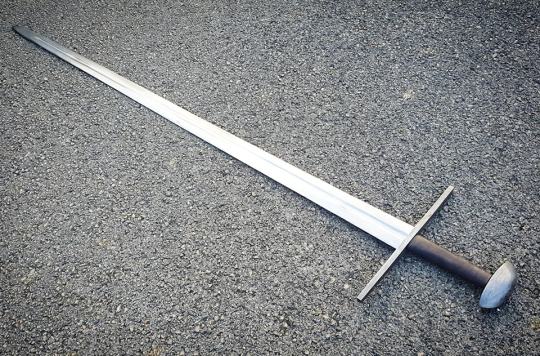

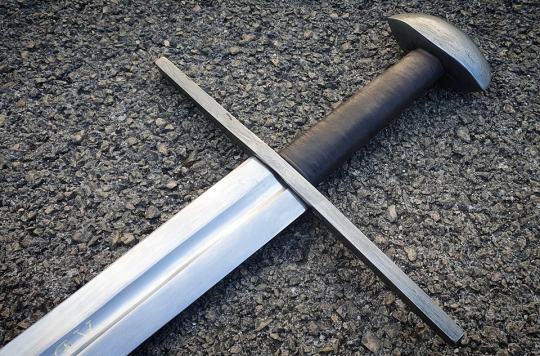

A Sword and Scabbard, in the style of the XI-XIIth centuries.
The blade itself follows one of the possible construction methods of the time, albeit being made of modern materials: a layer of high carbon steel forge-welded between lower carbon alloy. Thus hard steel is kept for the edges, and softer metal for the rest - which was also the point, as the fuller sports on both sides an inlay is brass, and although what it spells is not really historically accurate, the lettering at least is.
The straight Cross and Brazil Nut Pommel are of old iron with a nice, rich pattern, and both were made the "old way", with hammer and fire, according to methods I documented over the course of my PhD.
The Grip is vegetable tanned leather over linen thread over wood.
The scabbard is lined with parchment, and is made of beech wood covered in linen cloth - wrapped over near the point - and vegetable tanned leather. The decoration was made by gluing flax thread and leather cuts over the linen, and is inspired by folio 89 of the ms.002 (tome II) in the City Library of Boulogne-sur-mer.
The suspension system was heavily inspired by the wonderful scabbard in the treasury of the Bamberg cathedral (thanks to Roland Warzecha a.k.a. Dimicator for sharing this with us all), though here I used calf leather.
Chape is hand-forged in steel, and heat-blued.
It is 1018 mm long, with a 888 mm blade, 40 mm wide and 4.65 mm thick at its base. The span of the cross is 205 mm.
And although quite light (771 grams) it is still a powerful cutter, with a center of gravity some 18 cm down the blade.
Making this set was quite the learning experience, as it often is, and that's also one of the highlights of this trade.
Thanks to all who made this possible.
153 notes
·
View notes
Note
do u have a fave beginner sweater pattern/formula for knitting...i have a bag of undyed dk weight wool
my fav dk weight sweater pattern is the white mountains light raglan by midori hirose it comes in a range of sizes from a small child's to 6XL and multiple options for the neckline and sleeves. i've made the sleeveless vest version and it's super easy to follow, and i plan to make it as a full sweater soon. if you'd prefer a free pattern tin can knits' 'flax dk' pattern is a good alternative


82 notes
·
View notes
Text
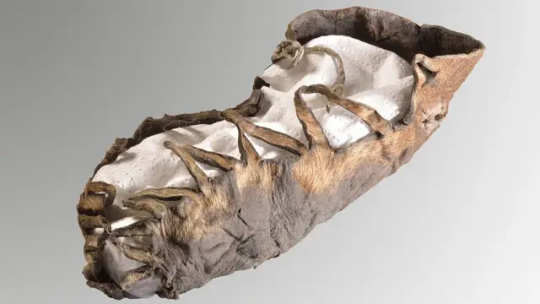
A 2,000-Year-Old Child's Shoe Found in Austria
Deep underground, an ancient child toiled away in a salt mine.
Perhaps their job was to shovel up discarded rocks. Or perhaps they carried precious materials to the surface. Maybe they had a different job entirely.
The only clue they left behind was a 2,100-year-old shoe.
Archaeologists were excavating a tunnel of an Iron Age salt mine in Dürrnberg, Austria, when they found the child’s shoe, according to an Aug. 31 news release from the German Mining Museum.
The small shoe was incredibly well-preserved, photo show. The worn, brown material is open down the center with a series of U-shaped hooks. It almost looks like a modern-day ballet slipper.
The shoe still had remnants of flax or linen laces, the release said. Based on its lace-up pattern and design, archaeologists identified the footwear as being made in the second century B.C.
Archaeologists said the shoe roughly corresponds to a modern European size 30 shoe. In U.S. sizing, this ranges from a kid’s 11 to 12 shoe size, according to conversion charts from Kiwi Sizing and SizeGuide.net. Although these modern sizes are commonly worn by 5-year-old to 6-year-old children, archaeologists did not indicate the child miner’s age.
During previous excavations in the Dürrnberg salt mine, archaeologists found several leather shoes, the release said. Still, children’s shoes are considered special finds because they prove that Iron Age children were present underground.
Near the shoe in the Georgenberg tunnel, archaeologists found half of a wooden shovel blade and some fur with lacing. The material was likely part of a fur hood, the release said. Archaeologists did not specify if or how these artifacts were connected to the shoe.
Organic material — such as those used in the shoe and fur hood — usually decompose over time, head archaeologist Thomas Stoellner said in the release. At the Dürrnberg mine, the natural preserving effect of the salt helps save fabric artifacts that typically don’t survive in other environments.
Excavations in the Georgenberg tunnel are part of a long-term research project in Dürrnberg, the release said. Archaeologists will continue excavating the salt mine to better understand the Iron Age people who once worked there.
Dürrnberg is about 190 miles west of Vienna and along the Austria-Germany border.
By Aspen Pflughoeft.


#A 2000-Year-Old Child's Shoe Found in Austria#Dürrnberg Austria#German Mining Museum#ancient artifacts#archeology#archeolgst#history#history news#ancient history#ancient culture#ancient civilizations#iron age
238 notes
·
View notes
Text
Making a modified Flax sweater from some of the yarn I bought this week

I like the flax pattern mostly because the math is done and it's easy to modify. Instead of the garter panels, I'm doing braided cables. I also dropped the neckline by casting on more stitches instead of increasing the full amount after the ribbing. Finally I'm adding a few short rows on the back to raise the back of the neck.
18 notes
·
View notes
Text
Might be slow here but for anyone struggling, for me personally the planting pattern that worked best looks like this:
Middle : Bee Balm (fertilize that shit)
Left : Chamomile
Right : Flax
Just slap the Bee Balm in the middle
Gets you both Druid's Sorrow and Lumopetal growing
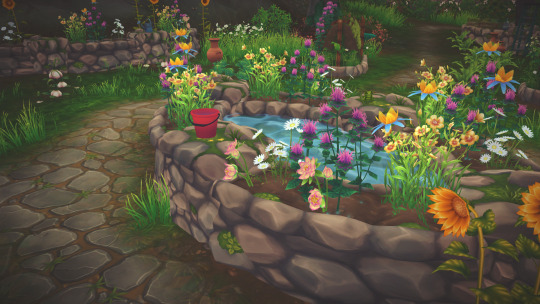
Look at that blooming gardussy
94 notes
·
View notes
Text
BTW I FINISHED THE SWEATER THIS PAST FRIDAY!!!! still need to block it but can confirm it's v cozy and warm :)

my mom said it looks like a color field painting :))
(pattern is flax by tincanknits, but modified in several places)
69 notes
·
View notes
Text
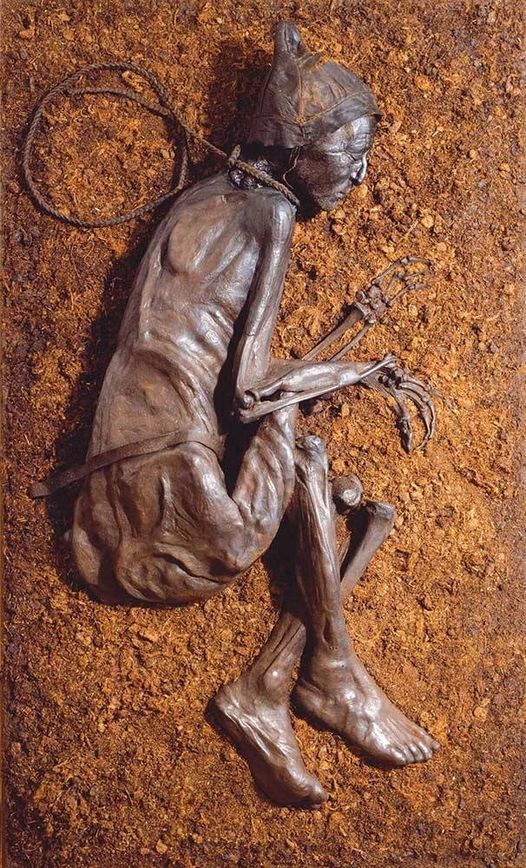
The Tollund Man (also Tollundmann; Danish Tollundmanden) is a bog body discovered by peat cutters on 8 May 1950 in a raised bog in Bjældskovdal, ten kilometres west of Silkeborg, Denmark. He is now on display in the ‘Hovedgården’ museum in Silkeborg.
The Tollund man was lying in a relaxed position on his right side, his legs drawn up to his stomach. With the exception of a sheepskin cap sewn together from eight pieces and a 77 cm long leather belt, he wore no clothing. It is possible that he was originally clothed in textiles made from plant fibres such as flax, hemp or nettles, which were decomposed by the acidic environment of the bog. He was estimated to be around 40 years old. At 161 cm, he was rather short, but probably also shrunk in the bog so that his skin lay in folds. His arms and hands had been damaged during peat cutting, but his feet and one of his fingers were well preserved. The papillary lines and skin line patterns on the soles of the feet were no different from those of modern humans.
The head was particularly well preserved. The facial expression was calm, mouth and eyes closed, and gave the impression of a sleeping person. He appeared well groomed. His hair was cut short and 2 to 3 cm long. The leather cap covering his scalp was fastened with two leather strips under his chin. The neck of the bog body was in a plaited leather sling, which had left clear marks in the skin on the sides and under the chin. The free end of the strap under the corpse was about a metre long and had been cut off at the end. Most of the upper body was still covered in skin. However, the left side of the chest and shoulder in particular were poorly preserved and partially decomposed. The genitals were well preserved, as were the internal organs such as the heart, lungs and liver. The stomach, small intestine and large intestine of the Tollund man still contained the remains of his last meal.
The noose still around his neck suggests that Tollund Man died violently by strangulation, although the doctor who carried out the forensic examination was certain that the man had not been strangled but hanged. The way he was laid in the bog - in a sleeping position with his eyes closed - suggests that he was not killed by enemies. It is likely that it was a human sacrifice, perhaps in gratitude for the peat or in winter as a plea for the coming spring. His death is dated to 405-380 BC.
63 notes
·
View notes
Text

Jotun Loki for @jotun-design-party
Loki clothes are inspired by this discussion where Jotun clothing is inspired by Henin period clothes. The cut of the clothing is meant to emulate snowflakes or icy shapes that occur in nature.
Wanted to go against the typical barbarian brutes Jotuns are so often depicted and have it be so they are a people that have diverse culture. Jotunheim is a winter-y world, but it still has flora and fauna. Leather and fur is probably something Jotun use in abundance, but they have silks, cottons and flax fabrics they know how to utilize. Again, an idea I really like is them knowing how to weave things that result in beautiful unique patterns that are inspired by the nature around them.
85 notes
·
View notes
Text

I'm facing my fears! This weekend I started knitting my first ever sweater. I'm far enough along that I don't want to frog and restart, but for future sweaters, I think I'll be doing a 1x1 twisted rib (only twisting the right side stitches). Also, either a long tail or German twisted cast on next time. The cast on I picked isn't really doing it for me, but again.... I don't want to restart!
The yarn is Malabrigo Mechita, Fiona colorway. Pattern us Flax Lite.

14 notes
·
View notes
Text

WEAVER | TS4 Medieval Career Mod
Becoming a Weaver places you in a respected and essential role within your community, crafting textiles that are the fabric of everyday life. You are entrusted with transforming raw materials like wool, flax, and silk into garments, tapestries, and goods that not only serve practical needs but also convey status and beauty. Your skilled hands weave together the threads of society, creating durable clothing for the peasantry, fine fabrics for the nobility, and ornate tapestries that tell the stories of heroes and history. This career will offer you a unique blend of artistry and practicality.. You will ensure that through your looms, the richness of medieval life is clothed in colour, pattern, and texture.
Medieval: Weaver includes 1 main track with 8 levels.
More career information about career levels can be found HERE
DOWNLOAD: HERE
Two week early access for patrons. Public release on the 10th May.
Any issues please get in touch via DM.
Enjoy! ❤
TOU: Please do not put my cc behind paywalls or re-upload. Link back to my Tumblr if you use my CC; I’d love to see it!
40 notes
·
View notes
Text


File This Pattern Under Quick Makes! Knit a Dandelion Tote Bag Designed by Shelby Mooney of Barley & Flax: 👉 https://buff.ly/44woR33
22 notes
·
View notes